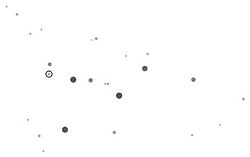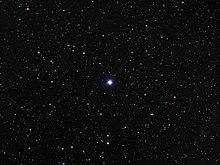| Observation data Epoch J2000.0 Equinox J2000.0 | |
|---|---|
| Constellation | Cassiopeia |
| Right ascension | 00h 31m 46.35935s[1] |
| Declination | +54° 31′ 20.2257″[1] |
| Apparent magnitude (V) | 4.772[2] (5.33 / 5.62)[3] |
| Characteristics | |
| Spectral type | B8 Vnn[4] |
| U−B color index | −0.35[5] |
| B−V color index | −0.10[5] |
| Astrometry | |
| Radial velocity (Rv) | −12.20±1.3[6] km/s |
| Proper motion (μ) | RA: +41.20±0.29[1] mas/yr Dec.: −16.54±0.35[1] mas/yr |
| Parallax (π) | 8.64 ± 0.43[1] mas |
| Distance | 380 ± 20 ly (116 ± 6 pc) |
| Absolute magnitude (MV) | −0.57[4] |
| Orbit[3] | |
| Period (P) | 245.70±35.96 yr |
| Semi-major axis (a) | 0.448±0.028″ |
| Eccentricity (e) | 0.689±0.119 |
| Inclination (i) | 53.6±5.2° |
| Longitude of the node (Ω) | 17.6±9.6° |
| Periastron epoch (T) | 2025.54±4.56 |
| Argument of periastron (ω) (secondary) | 301.0±2.6° |
| Details | |
| λ Cas A | |
| Mass | 2.9+0.45 −0.40[7] M☉ |
| Radius | 3.50[8] R☉ |
| Luminosity | 255[4] L☉ |
| Surface gravity (log g) | 4.0±0.25[7] cgs |
| Temperature | 12,000±1,000[7] K |
| Rotational velocity (v sin i) | 253[9] km/s |
| Age | 58+104 −48[7] Myr |
| Other designations | |
| Database references | |
| SIMBAD | λ Cas |
| λ Cas A | |
| λ Cas B | |
Lambda Cassiopeiae, Latinized from λ Cassiopeiae, is a binary star system, in the northern constellation of Cassiopeia. The system has a combined apparent magnitude of +4.74, making it faintly visible to the naked eye. With an annual parallax shift of 8.64 mass,[1] it is approximately 380 light years from Earth. The system is moving closer to the Sun with a radial velocity of −12 km/s.[6]
Both components are blue-white B-type main-sequence stars. The brighter member, component A, has an apparent magnitude of +5.5, while its companion, component B, has an apparent magnitude of +5.8. The two stars are separated by 0.6 arcseconds and complete one orbit around their common centre of mass about once every 250 years.[3] The primary displays an infrared excess, possibly due to a debris disk or other orbiting material.[8]
References
- ^ a b c d e f van Leeuwen, F. (2007). "Validation of the new Hipparcos reduction". Astronomy and Astrophysics. 474 (2): 653–664. arXiv:0708.1752. Bibcode:2007A&A...474..653V. doi:10.1051/0004-6361:20078357.Vizier catalog entry
- ^ Høg, E.; et al. (2000). "The Tycho-2 catalogue of the 2.5 million brightest stars". Astronomy and Astrophysics. 355: L27–L30. Bibcode:2000A&A...355L..27H.
- ^ a b c "Sixth Catalog of Orbits of Visual Binary Stars". United States Naval Observatory. Retrieved 16 May 2017.
- ^ a b c Anderson, E.; Francis, Ch. (2012), "XHIP: An extended hipparcos compilation", Astronomy Letters, 38 (5): 331, arXiv:1108.4971, Bibcode:2012AstL...38..331A, doi:10.1134/S1063773712050015.
- ^ a b Mermilliod, J.-C. (1986). "Compilation of Eggen's UBV data, transformed to UBV (unpublished)". Bibcode:1986EgUBV........0M.
- ^ a b Kharchenko, N. V.; et al. (2007). "Astrophysical supplements to the ASCC-2.5: Ia. Radial velocities of ~55000 stars and mean radial velocities of 516 Galactic open clusters and associations". Astronomische Nachrichten. 328 (9): 889. arXiv:0705.0878. Bibcode:2007AN....328..889K. doi:10.1002/asna.200710776.
- ^ a b c d Gullikson, Kevin; et al. (August 2016). "The Close Companion Mass-ratio Distribution of Intermediate-mass Stars". The Astronomical Journal. 152 (2): 13. arXiv:1604.06456. Bibcode:2016AJ....152...40G. doi:10.3847/0004-6256/152/2/40. 40.
- ^ a b Cotten, Tara H.; Song, Inseok (July 2016), "A Comprehensive Census of Nearby Infrared Excess Stars", The Astrophysical Journal Supplement Series, 225 (1): 24, arXiv:1606.01134, Bibcode:2016ApJS..225...15C, doi:10.3847/0067-0049/225/1/15, 15
- ^ Zorec, J.; Royer, F. (January 2012), "Rotational velocities of A-type stars. IV. Evolution of rotational velocities", Astronomy & Astrophysics, 537: A120, arXiv:1201.2052, Bibcode:2012A&A...537A.120Z, doi:10.1051/0004-6361/201117691.

